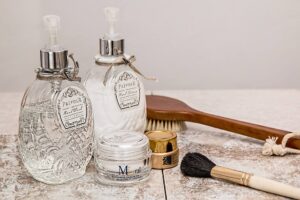Best Winter Skin Care Routine – As we enter the winter season, it’s time to invest in some major beauty products. Your skin may not be able handle dry air and indoor heaters so if you want your face looking its best come December make sure that these three things are on hand: a lightweight gel moisturizer or lotion; an oil free cleansing cloth (like this one!) for removing any dirt before applying makeup at night-time; And lastly but certainly not least — charcoal masks!
As colder temperatures approach there will always need more than just clothes changes when trying get ready early enough – our barrier functions definitely cannot take too much strain from general exposure both inside out over long periods like. The body is a complex machine and sometimes it can be hard to keep up with everything. The skin, for example; the largest organ in our bodies that covers over 60% of your total surface area!
If you’re like me then at some point or another during this process (or any other) something has gone wrong- either internally or externally -and now there’s irritation going on down below which leads us right back. “You don’t have to go all in with an entire overhaul,” says Doris Day, MD. “Swap out some products and adjust the rest accordingly.” She adds that you need be careful about using more gentle cleansers or richer moisturizers depending on your skin’s needs at this point – just take care not too overdo it! The best way for most people is by making small changes so they can see if their routine works well without completely changing everything around them when often times only one tweak will do what’s needed.
To keep skin happy and hydrated—and flaky freak-outs far away–follow these dermatologist-recommended skincare switcheroo’s to execute a seamless transition.
- For dry/comedy masks, use an oil based product like coconut or olive oils as face mask instead of water because it will help the moisturizer sink into your facial muscles better.
- To prevent blackheads from coming back after using benzoyl peroxide acne treatment , follow up with sulfur based cleanser.
- And lastly but most importantly for those who wear makeup all day long at work.
What Is an Emulsifier In Skin Care
The unsung heroes of many cosmetics formulas are the emulsifiers, which help to keep unlike ingredients together. This includes any ingredient that can be classed as “emulsion stabilizer.” These work in all kinds and styles of skin care products including foundations, lipsticks or eye shadow colors on eyelids; moisturizers for dry patches such as eczema caused by windburn: they’re even used during production processes like making laundry detergents!
Use Balm, Oil, Or Cream Cleanser
Foaming, bubbly cleansers are fun to use on your face because they clean dirt and oil well but can be more drying than other types of products. Cleansing creams work by washing the skin while still keeping moisture in it which is why you’ll find them beneficial for sensitive complexions with dry patches.
One type that deserves attention from any woman looking for healthy-looking beauty is cleansing oils – these miracle workers provide deep surface hydration without disrupting barrier function so much compared to harsh detergents found within traditional soap bars! If you suffer from acne, be careful with skincare that contains salicylic acid and benzoyl peroxide. These harsh ingredients can lead to more dry skin if used in excess; it’s important for those struggling with their complexion not only use these products but also pH-optimized ones like CeraVe lotion (formulated specifically for sensitive skins ) together as they work synergistically .
Add a Good Exfoliator
Exfoliation is an essential step in your skin care routine. The benefits are no secret, but it’s important to find the right product for you and make sure its gentle enough so as not cause any damage or discomfort – which can lead them away from using exfoliant altogether!
Exfoliators help remove dead cells accumulated on dry winter air by giving their products a rough texture that sloughs off old layers of topmost surface cells with one use each time before applying moisturizer afterwards according to board certified doctors like Dr Hadley King who say this will give better absorption when applied post-cleaning.
It’s a well-known fact that we live in a society of over-exfoliators. But don’t do it too much! Exfoliating can help brighten our skin by removing dead cells, but if done wrong or too often it may lead to dryness and irritation on your outer layer which could make matters worse for you instead. You should exfoliate only once per week at first then advance twice weekly as long as there are no major concerns with sensitive skins.
Eliminate Shower Time & Temperature
Winter is a great time to give your skin all the moisture it needs. In winter, hot water can strip away natural oils and even lead people who bathe in it for too long be drier than before they took their shower! Dr King suggests taking lukewarm showers no more than once per day with just enough soap sudsing up on you as well-so that when summer comes around again (and we know how much sun loves showing off our best assets), those Assets will still look good by giving them some love then too: apply rich moisturizers right after getting out of bath/shower; use about two tablespoons worth which should feel substantial but not overwhelming since excess fluid tends make us oily rather.
Imagine the feel of soft bristles against your skin. You can do this at home by hand or with an electrical brush, which will absolutely leave you wanting for more! The light scraping motion is perfect if your complexion is dry and sensitive due to winter weather conditions like excessive heat exposure in summertime coupled up close contact between warm surfaces (i.,e clothes) throughout long hours outside resulting into lacklustre airflow circulation creating hyper-sensitivities on irritated areas such as face ears hands etc.
Use Moisturizer Cream
The key to keeping your skin looking and feeling its best this winter is hydration. Lighter lotions may have been enough during summer, but they won’t cut it in colder months with lower humidity levels. “While humectants were sufficient for keeping the body’s moisture level high throughout hot days of July or August when we sweat profusely due to heat exposure, emollients and occlusive will become more important as our bodies enter low-humidity conditions where evaporation from breath condensation has a greater impact on how quickly those natural processes proceed,” says Dr King.
Before we dive into the juicy part, let’s back that up. When you put on your favorite moisturizer or lotion for instance, what are some of the first things happening? Well—hydration is at an all-time high with ingredients like humectants (hyaluronic acid and glycerin), emollients help to protect skin barrier function by providing moisture needed in dry areas which also have occlusives oils/waxes so nothing escapes! Dr. King says that an ideal winter moisturizer should contain all three components: water, fat (shea butter), and protein. But don’t worry—these heavier moisturizers can still be non-comedogenic so you won’t break out with them!
Layer Your Skincare
Every skin type needs to think about what they wear every day. The weather and climate we live in dictates how our bodies work, so it’s essential that we layer accordingly for optimal performance. “Just like you would not go out without a coat on an autumn morning here in New York City,” says Dr. Zeichner – same goes with skincare! The best way to layer your skincare is by starting with the lightest products and working up. This will allow for some gentle exfoliation, which in turn allows you more product absorption at each stage of application while also preventing any excess oil build-up! Your body is more than capable of dealing with the sun’s UV rays. Even if you’re not exposed during summertime, winter will make up for it by accentuating your natural tan and giving off some negative effects like sore eyes from strong glare or premature aging due to photo-aging agents in snowfall!
When the winter months come, your skin may suffer from harsh conditions and low temperatures. It is important to take care of yourself during these times so you can stay healthy!
Incorporate an overnight mask. Many people fear that opened skin care products will spoil quickly, but this doesn’t have to be the case. Unopened packages can last from one-to three years in your house before they start losing effectiveness and need replacing. After opening an item up it’s best not just use as directed on schedule (or within a year), but also make sure you follow these simple rules: clean by washing hands with soap; throw away any used product if there are signs like discoloration or strange odor–these could indicate bacteria has grown which would cause infection!
Not that we needed any excuse to apply a face mask, but if you haven’t started yet this winter is the best time. Overnight masks work by being applied at night and helping lock in all those serums, creams and oils from our daytime skincare routine while also acting as an extra step before bedtime for healthy glowing skin! Masks can be tricky because they might feel too heavy or greasy on your sensitive epidermis so it’s important know which ones will suit us best. “Your choices should match what type of results,” says Dr Zeichner.
The skin’s natural moisture levels can quickly deplete in the afternoon and continue overnight, so it is important to add some p.m. masking for an extra boost of hydration when you sleep. Pair your favorite bedside humidifier with any night time ritual that includes cleansing, exfoliation or serum application before turning out lights; this will help lock down all those beneficial nutrients from earlier today!

Stay in touch with us for more information about how you can improve your overall wellness. Stay up-to-date on all the health related news from around our site, so that when it comes time to make changes or take care of yourself we have everything at hand!
